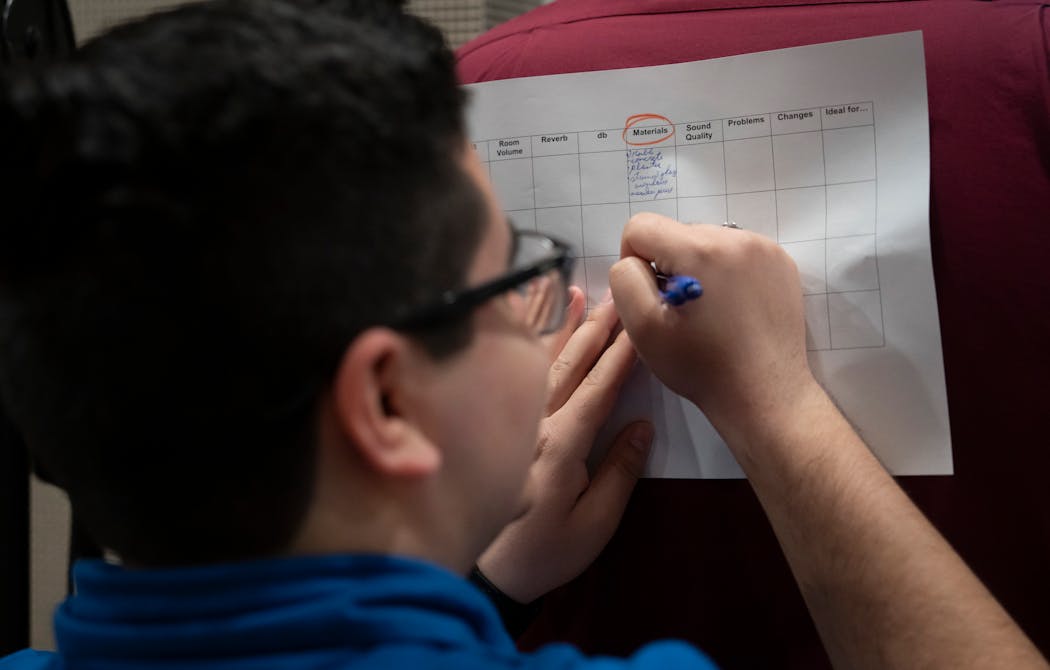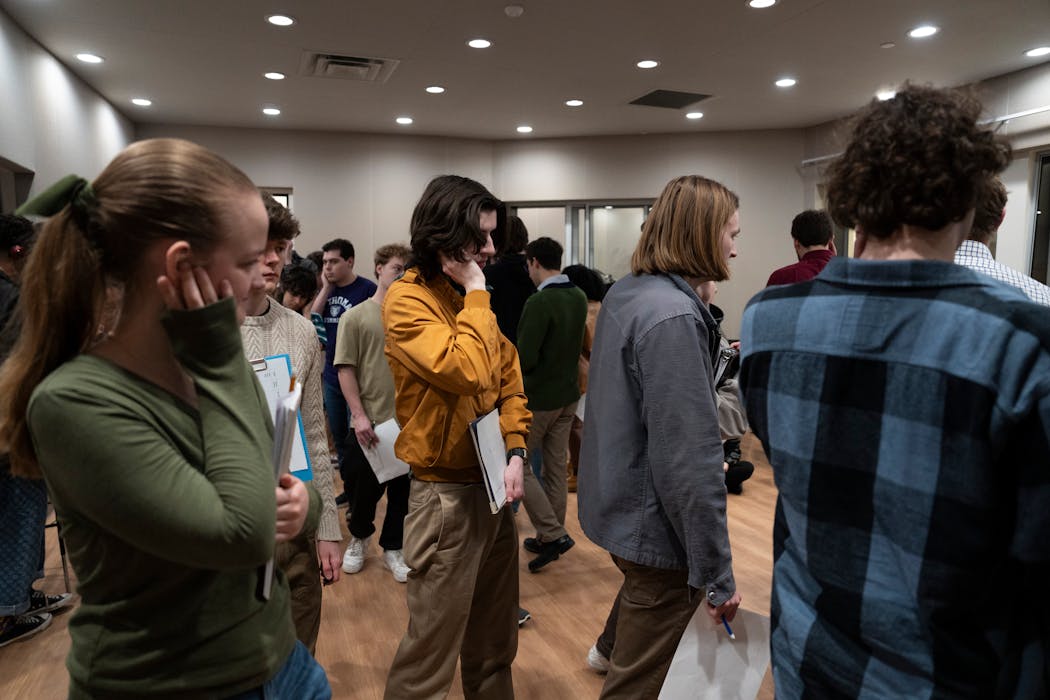Calvin O'Connor played scales on his trumpet while classmates dashed around a University of St. Thomas chapel to measure the dimensions of the room. Some logged how loud the music was. Others tracked how long it took the sound to travel.
O'Connor, a music education major, ended up there because, "I wanted to try to take a physics class." Ndeh Awasum, who's studying data science and business, was intrigued by a class that melded the hard sciences and the arts.
Musical Acoustics teaches students how physics affects music. The course — taught by a physics professor and a music professor — is an example of the cross-disciplinary work that colleges are increasingly trying to promote.
Schools across Minnesota approach interdisciplinary or multidisciplinary work in myriad ways and for various reasons, including preparing students for the workforce or helping colleges trim costs. Some universities have been offering interdisciplinary classes for decades and are building new facilities to encourage the work. Others are offering entire degrees aimed at helping students whose passions cross different sectors.
Robert McMaster, vice provost and dean of undergraduate education at the University of Minnesota's Twin Cities campus, suspects interdisciplinary classes are gaining attention for one simple reason: "The problems that we're facing are so complicated that it's very rare that one discipline is able to provide the full answer to solving that."
Many problems need multiple solutions
For nearly a decade, the U's Twin Cities campus has offered a Grand Challenge Curriculum, where professors with different expertise work together to help students tackle a major societal issue. For example, a course called "Can We Feed the World Without Destroying It?" has been taught by professors specializing in ecology and bioproducts and biosystems engineering.
At Bemidji State University, which is trying to rebound after years of enrollment drops and budget crunches, leaders hope a reorganization will allow them to both cut administrative costs and better prepare students for the workforce. Instead of 21 different departments, by next fall the university will have nine schools that aim to encourage collaboration. For example, the School of Sustainability and Life Sciences will combine biology, economics, environmental studies, geography and Indigenous studies.
President John Hoffman said studies show many employers value the skills students gain in general education courses as much as the ones they gain in their majors. With an increasing number of students already coming to college with general education credits, multidisciplinary classes offer another way to ensure students are getting a well-rounded education.
"At Bemidji State, we are literally reorganizing the university to drive greater interdisciplinarity in our majors to ensure students graduate with the skills they need to succeed at future jobs," Hoffman said.
Minnesota State University, Mankato, offers an interdisciplinary studies degree that allows students to work with an adviser to design their own program. For example, someone who wants to become an art therapist might take classes in both the art and psychology departments.
About 50 students participate in the program in a typical year. Some are high achievers with specific career goals that don't neatly fit into an existing major. Some decided they want to switch majors without delaying graduation. Some are returning to school to complete a degree after time away, often in hopes of landing a promotion at work.
"The degree design is as unique as each student we have," said program director Alisa Eimen.
'The light comes on'
Music professor Doug Orzolek has been teaching the acoustics class at the University of St. Thomas for more than 20 years, alongside a physics professor. He enjoys watching how music and science students approach the same tasks from different perspectives, teaching each other how to view their disciplines in new ways.
"We want them to become independent thinkers and learners and scholars, asking these questions that feel random and out of the blue," Orzolek said.
When the university began designing its new Schoenecker Center, it recruited Orzolek and other professors to provide feedback on how they could build a space that encourages students from different disciplines to interact with each other. The center, which opened earlier this year, has become a sort of laboratory for Orzolek's class.
Awasum wasn't sure what to expect when he signed up but added, "It's been very nice."
On a recent afternoon, he and his classmates roved about the Schoenecker Center and the nearby seminary, logging various metrics as O'Connor played his trumpet.
In each space, students noted whether the room was full of hard surfaces or padded by soft, sound-absorbing curtains. They talked about whether the windows were installed straight or at an angle. They took recordings before and after Orzolek dropped banners down from the ceiling. Then they talked about how each of those factors changed the sound and whether it made the spaces better for practicing, recording or performing.
Kori-Ann Hermitt hopes the lessons she learns here will help prepare her for a career on Broadway.
"The music drew me to it for sure," said Hermitt, who is studying music and business. "But I was intrigued by how music and physics are related."
Orzolek and physics professor Jeff Jalkio, who teaches with him, hope the class will help students see the ways different subjects overlap and feel more comfortable trying tasks outside their comfort zones.
"What's amazing is watching the students make those connections," Jalkio said. He added that he loves watching "the lights come on when all of a sudden they make this connection between the way the instrument works and what they've been told to do."
Carolyn Parnell, 'trailblazer' who served as Minnesota's first IT commissioner, dies





